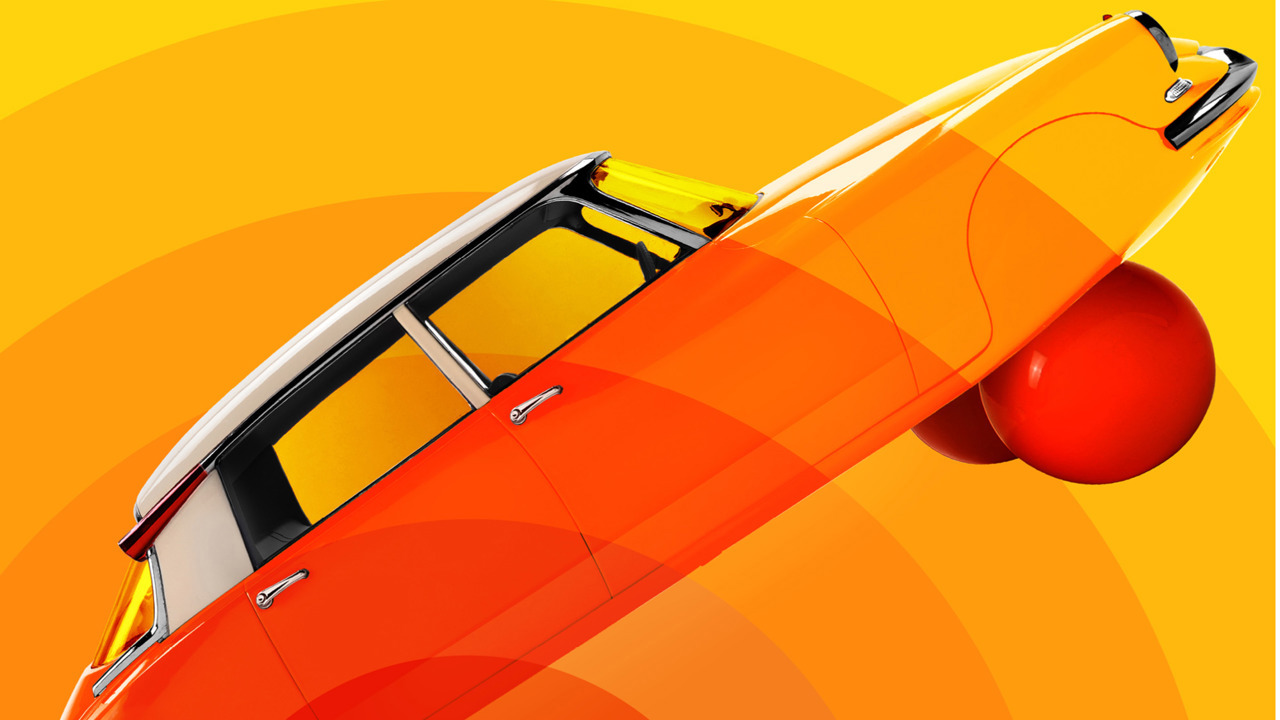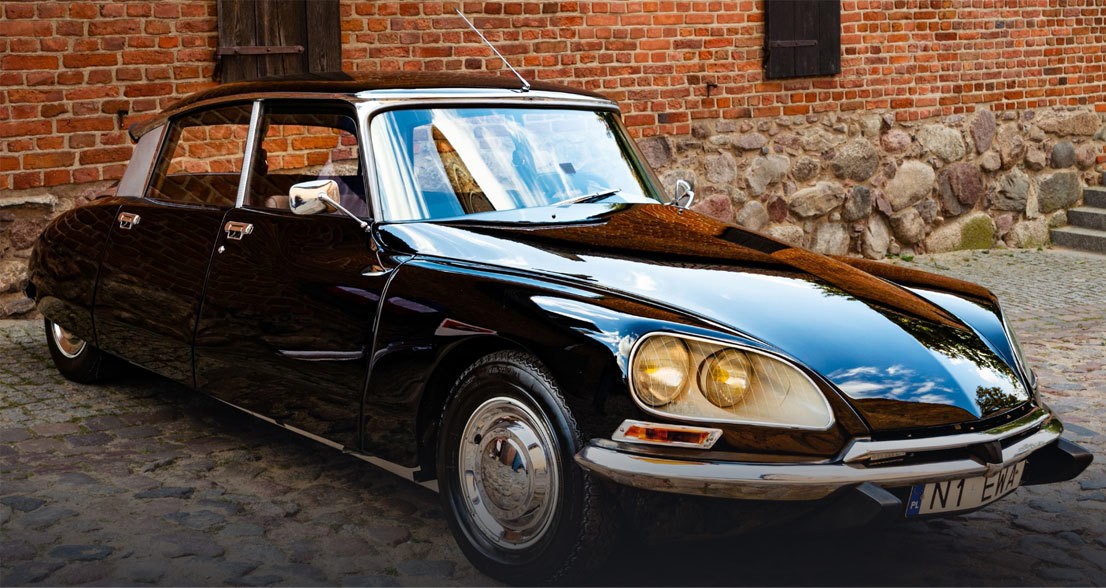23 November 2025
70 years of the Citroën DS
4 minutes
Can it really be 70 years since the Citroën DS made its vehicular catwalk debut at the 1955 Paris Motor Show? With its futuristic, sleek and rarely seen hydropneumatics suspension and disc brakes, it was as much a piece of avant-garde art as it was a drivable object, thus proving to be a truly traffic-stopping moment in the history of car design.
Retromobile’s star turn
This past February (2025), Retromobile Paris celebrated more than seven decades of the space-age car with an exciting retrospective, that quite frankly (French pun intended), pretty much blew the bloody doors off all other motors and shows.
From the enticing publicity poster featuring an early orange Citroën DS mounted on spherical red balls (the DS19 Ballon first seen in 1959 to emphasise the advanced hydropneumatic self-levelling suspension), to the artfully curated collection of twelve models arranged within the Porte de Versailles Paris exhibition centre, this was less classic car show, and more major art installation.

Illuminated throughout by Mathieu Lustrerie, further Citroën DS models included an ID19 base model), and a much more practical multi-seat Break (known as Safari here in the UK), as well as the oft-desired Chapron-bodied cabriolet.
We should also pay homage to the coachbuilt Frua Coupé, the short-wheelbase Work’s DS Coupé. This may have lost a wheel at the Chamonix Ice Rallye in 1970 but still managed to steal victory. Classic car enthusiasts take note – a bright yellow 1957 DS19 was on sale for an astonishing six-figure sum! Plus, there was an entire stand devoted to regular Citroëns equipped with the hydropneumatic self-levelling suspension system, from the humble GS thorough to the popular BX, the Xantia, CX, XM, C5, C6 and stunning SM.
Beautifully and thoughtfully lit by Mathieu Lustrerie, a selection of around ten important DS derivatives from the model’s 20-year production run were on display, including early bold-coloured saloons, an ID19 (the base model), practical multi-seat Break (Safari in the UK), plus a much sought-after Chapron-bodied cabriolet.
Once upon a Citroën
Back in the mid-50s, as post-war austerity finally made way for a more optimistic era, there was a noticeable shift across the entire cultural landscape… and there was no country better placed to lead this style charge than France. Dior’s ‘New Look’ was transforming fashion, Jean Luc-Goddard and Francois Truffaut were on the cusp of becoming the ‘enfant terrible’ big names in French New Wave cinema, which meant there was a clear spot vacant for an equally iconic and forward-thinking French car to complete the revolutionary line-up.
This is where the Citroën DS enters the picture. Aerodynamic, futuristic, and a whole lot quirky, it embodied the true essence of ‘joie de vivre’ while also offering a better standard of handling and ride quality.
Unlike French fashion show outfits – which are often admired for their uniqueness and élan, but rarely purchased – the Citroën DS immediately defied that trend with thousands of fans clamouring to put in an order. In fact, within the first 15 minutes of the show, 743 orders were received, jumping up to 12,000 by the end of the day, and 80,000 across the full ten days. This car order was record-breaking and remained so for sixty years until Tesla stole that crown.
The original iteration of the Citroën DS wasn’t entirely a French endeavour. It was the Italian sculptor and industrial designer Flaminio Bertoni that came up with the design, while aeronautical engineer André Lefèbvre handled the styling and engineering, and Paul Magès completed the triumvirate as the name and smarts behind the hydropneumatic self-levelling suspension.
State-of-the-art technology from the start
What the Citroën DS did so well, even in the very early days, was to combine a seductive aesthetic with entirely useful innovation. The double wishbone suspension with L-shaped arms at the front supported by rear-paced trailing arms provided superhero dimension. Paired with hydropneumatic spring and damper units, better-than-ever hydraulics including automatic self-levelling and driver adjustable ride-height, the full package deserved the hype and orders it received – especially as the suspension gave the DS the necessary va-va-voom to manage France’s far-from-excellent road conditions back then.
To put this into a timely perspective, around this time hydraulics had limited use, mainly for brakes and power steering. Then along came the Citroën DS which successfully incorporated this for suspension, clutch, and transmission as well. This gave the car the enviable ability to master sharp handling while never compromising on the quality of the car journey, This elevated the mythical, car-of-tomorrow status even further, with many likening it to a magic carpet.
And we’re not done yet. It was almost as if the engineering team really did have a crystal ball, with further notable features including power steering, semi-automatic, and a fibreglass roof. Not just a way to occasionally admire the stars, this lowered the centre of gravity, thus reducing weight transfer. Then there are those aforementioned disc brakes that worked to minimise unsprung weight - the first time these had been applied to a mass-produced motor.

Making motorsport history
It was clear that such a car model would find itself in the lineup for motorsports – a true ‘coup de foudre’.
Rallying was where the DS found greatest success, thanks to the specific engineering that made it so resilient on varying road surfaces. Great victories included the Monte Carlo rallies of 1959 and 1966, plus the 1000 Lakes Rally of 1962, and the Rallye du Maroc in 1969 and 1970, which was won by Robert Neyret in a DS 21.[28]
The final major motor racing win in a Citroën DS was in the 1974 London-Sahara-Munich World Cup Rally. This was a hard-earned access, heavy on grit and determination, light on drivers who even completed the race. Only five out of 70 starters made it to the finishing line. The DS owes much of its racing ability to the centrelock wheels. A captive allen bolt acted as the central fastener whilst a hexagonal protrusion meant a fast wheel change could be swiftly enacted, even in the most challenging of conditions.
A place in history
While Citroën DS models haven’t troubled the car production line since the mid-1970s, their popularity and impact on the classic car market remains strong. Just before the millennium in 1999, a Car of the Century poll put it in bronze position as one of the world’s most influential car designs of the 20th century, while Classic & Sports Car magazine took this up a gear, naming it the ‘most beautiful car of all time'.
Taking a look at current price listings, we noted a striking 1963 Citroën DS19 Usine Convertible priced at a whopping £114,129, with a 1974 DS model requesting a relatively modest £16,924.
It’s with a piece of related trivia that we end. In French language, DS is pronounced ‘déesse’, which translates as ‘goddess’. And for an iconic car range such as this, could there be a more suitable name?
Bonne anniversaire Citroën DS, and thanks for the futuristic ride.
If you’re looking to invest in a classic car and want to make sure you have the most suitable insurance to protect your vintage vehicle, speak to our specialist Classic Motor Trade team today on
020 7623 3806, or come here for a quote.
